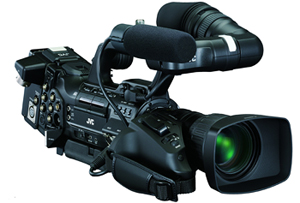JVC Expands ProHD, 3D Options at NAB

GY-HM790 ProHD Camcorder
To set the stage for JVC’s new product announcements for the NAB Show, Dave Walton, the company’s marketing communications manager took a moment to explain the path JVC set a few years ago with their ProHD format.
“When we designed ProHD, we designed it to move forward,” he said, characterized by high quality MPEG-2 compression, non-proprietary files, and by a compact shoulder mount form factor. And while the company has enjoyed good sales of its GY-HD250 camcorder, which pioneered the 1/3-inch imager, removable lens camera category, the move by many stations from tape to solid state recording media was rendering the DV-tape recording HD250s obsolete.
SLED OPTION
Last year JVC brought the solid-state recording GY-HM700 to NAB, but it had somewhat fewer capabilities than the HD250. So at the company’s pre-NAB briefing, Walton took the wraps off the GY-HM790, a 1/3-inch solid-state camcorder with all the capabilities of the HD250, and more.
The HM790 has the pool-feed recording, genlock and timecode in/out features from the HD250, but adds a modular design to replace the sled that was necessary to integrate 250s into a studio or other multicamera production. In place of the sled that needed to be connected by cables, the HM790 accepts modules that attach to a connector on the camcorder’s rear that provide 26-pin multicore or fiber-optic connection to a camera con-trol unit (CCU), or an ASI encoder to feed HD signals directly into a microwave transmitter.
A sled, minus the cabling, is still available to mount large, box-style lenses for studio or OB type operation. And where customers looking at JVC’s earlier 1/3-inch imager camcorders expressed concern that the choice of lenses was very limited, Walton pointed to a number of choices available today, with more on the way. “The lens companies are really on-board with this for the long-haul, so we feel we made the right choice with this,” he said.
For field ENG and production work, the HM790 records to non-proprietary consumer Class 6 SD cards. “Because we’re using the Sony HDCAM-EX recording platform, there will be no compatibility issues with the recording codec,” added Craig Yanagi, JVC manager of marketing and brand strategy. Editing of .MOV files can begin immediately, without transcoding.
NEW MONITORS
JVC is also bringing a new G series of monitors to NAB. “G” denotes the monitors’ capability of accepting a 3G video feed, necessary to view video di-rectly off an HDCAM SR deck in 4:4:4. The G1Z series “have new LCD panels that have a wider viewing angle, and a much wider color gamut,” said Walton. “The color gamut on these monitors is essentially 105 percent of Adobe RGB.”
He also cited low latency, less than one frame, to eliminate lip-sync issues, the inclusion of digital closed captioning display, and large waveform, vec-torscope and RGB meters that can be displayed. The 17-inch DT-V17G1Z and the 24-inch DT-V24G1Z are designed for broadcast, studio, mobile, and field applications that demand accurate color reproduction for critical image evaluation.
JVC will also bring a pair of products to the show aimed directly at the burgeoning 3D production market. The first is the company’s 46-inch GD563D10 3D monitor shown previously, which is viewable with the same inexpensive, passive, circularly polarized glasses used for RealD 3D viewing in theaters. “We’ve found people get fewer headaches with the passive system than they do with the active 3D systems,” said Walton.
The second 3D product is the IF-2D3D1 Stereoscopic Image Processor, which can perform a pair of functions: combine the left camera and right camera views from a 3D source into a 2D viewable signal for display on non-3D monitors, and convert a 2D signal into a 3D signal.
Walton was careful to clarify the second function, stating that it’s not a “magic box.” But through JVC’s patented algorithms, the processor “looks at colors, looks at brightness, and looks at the objects in the image,” he said, “and it generates a depth-map that allows it to separate the left and right camera angles.”
Don’t expect to run a 90-minute movie through the processor in real-time and expect it to yield a marketable 3D version, he said. “But what stereographers have told us is that the box can speed the process up. It doesn’t eliminate their job.”
But he did predict the IF-2D3D1 might find itself incorporated into live sports and event 3D productions for ancillary cameras. Not all of the camera positions are likely to be equipped with stereo-pair cameras in a 3D rig. “We can feed some [2D] shots through the processor, so for a blimp cutaway or something like that, we’ll have a 3D effect that looks pretty convincing… so in that sense we think it’s going to be a very popular tool for people who are producing in 3D.”
The professional video industry's #1 source for news, trends and product and tech information. Sign up below.
